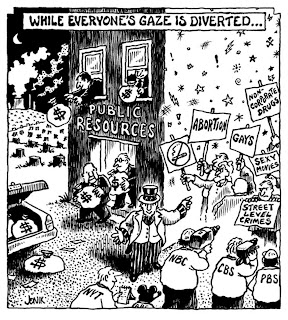American politicians, mostly united
Here's another cartoon by J. Jonik, with his permission:

Here's another cartoon by J. Jonik, with his permission:

At Bible Funmentionables, Michael G. Morris let's his hair down and reports all the details: An Amish gang armed with semi-automatic shears snuffed out the beards of five other Amish men last year. This case has gripped the nation like few other Amish-on-Amish attacks. Unwilling to plea their case down to involuntary beardslaughter, the trial is currently under way in Cleveland, Ohio.
Obama Administration’s is waging a war on the Constitution, but you'll barely hear anything about it in the mass media. At Truthout, John Cusack of Truthout recently interviewed law professor Jonathan Turley. It's an extended interview that raises many serious points. They explore at depth the moral quandary many voters SHOULD feel, but won't, when enter the voting booth. In a related matter, they suggest that many Obama supporters are followers of a personality cult. And repeatedly, the mass media is going Obama license to do more of the same, despite the lies, despite the trashing of the U.S. Constitution. Here are two excerpts from the long interview:
CUSACK: I hate to speak too much to motivation, but why do you think MSNBC and other so-called centrist or left outlets won't bring up any of these things? These issues were broadcast and reported on nightly when John Ashcroft and Alberto Gonzalez and Bush were in office. TURLEY: Well, there is no question that some at MSNBC have backed away from these issues, although occasionally you'll see people talk about – CUSACK: I think that's being kind, don't you? More like "abandoned." TURLEY: Yeah. The civil liberties perspective is rarely given more than a passing reference while national security concerns are explored in depth. Fox is viewed as protective of Bush while MSNBC is viewed as protective of Obama. But both presidents are guilty of the same violations. There are relatively few journalists willing to pursue these questions aggressively and objectively, particularly on television. And so the result is that the public is hearing a script written by the government that downplays these principles. They don't hear the word "torture." They hear "enhanced interrogation." They don't hear much about the treaties. They don't hear about the international condemnation of the United States. Most Americans are unaware of how far we have moved away from Nuremberg and core principles of international law. [More . . . ]
Hidden handshake between Romney and David Koch. Amy Goodman reports.
The hucksters are about to fill the airwaves with misinformation. From the New York Times:
Soon retirees and other investors will be barraged with advertisements for private stock offerings — via mail, cold calling, television, radio, billboards, the Internet and so on.Such advertising, which used to be banned under federal securities law, will make it easier for hedge funds, venture capitalists, start-ups and other nonpublic companies to find investors. It will also make it easier for hucksters and rip-off artists to lure people into unsuitable investments and outright frauds because private offerings are not subject to disclosure requirements and other investor protections that apply to publicly held companies. Bipartisan majorities in Congress and President Obama are to thank for this development. Bowing to the financial industry, they joined forces last April to pass a law that requires the Securities and Exchange Commission to lift the ban on mass advertising of private offerings.